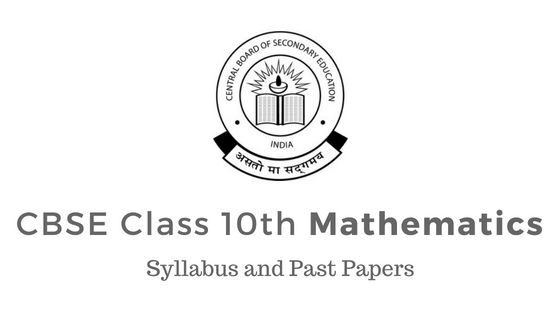CBSE Class X Mathematics (Code No. 041) Syllabus 2024-25. Check out CBSE Class 10th Mathematics Syllabus, CBSE Class 10th Mathematics Previous year question papers, CBSE Class 10th Mathematics Sample Papers. Check out CBSE Class 10th Syllabus and Past Papers of other CBSE Class 10th Course CBSE Class 10th Science Syllabus 2024-25 and Past Papers, CBSE Class 10th Mathematics Syllabus 2024-25 and Past Papers, CBSE Class 10th English Language And Literature Syllabus 2024-25 and Past Papers, CBSE Class 10th English Communicative Syllabus 2024-25 and Past Papers, CBSE Class 10th Social Science Syllabus 2024-25 and Past Papers or check out CBSE Class 10th Previous Year Question Papers and Sample Papers Solved. Continue to read for CBSE Class 10th Syllabus Mathematics alongwith CBSE Class 10 Maths Exam Syllabus Breakdown, and Marking Scheme.
The CBSE Class 10 Maths exam plays a crucial role in a student’s academic journey. Understanding the syllabus structure, marking scheme, and important details can significantly boost exam preparation. This article provides a comprehensive breakdown of everything you need to know about the CBSE Class 10 Maths exam.
The syllabus for CBSE Class 10 Mathematics is organised into the following units:
Number Systems: This unit covers the basic concepts of numbers and number systems, including the natural numbers, whole numbers, integers, rational numbers, and irrational numbers.
Algebra: This unit covers the basics of algebra, including algebraic expressions, equations, and inequalities.
Geometry: This unit covers the basics of geometry, including points, lines, angles, triangles, quadrilaterals, circles, and areas and perimeter.
Coordinate Geometry: This unit covers the basics of coordinate geometry, including the coordinate plane, distance formula, and section formula.
Trigonometry: This unit covers the basics of trigonometry, including angles, ratios, and trigonometric functions.
Mensuration: This unit covers the basics of mensuration, including the concepts of length, area, and volume, and the formulas for calculating these quantities.
Statistics and Probability: This unit covers the basics of statistics and probability, including data collection, representation, and analysis, and the concepts of probability and statistical measures.
Section – Wise Weightage – CBSE Class 10th Mathematics 2024-25
Maths Unit-Wise Marks Distribution, the CBSE Class 10 Maths exam is divided into seven units, each carrying a specific weightage in the final marks. Here’s a detailed breakdown:
| Units | Unit Name | Marks |
| I | NUMBER SYSTEMS | 06 |
| II | ALGEBRA | 20 |
| III | COORDINATE GEOMETRY | 06 |
| IV | GEOMETRY | 15 |
| V | TRIGONOMETRY | 12 |
| VI | MENSURATION | 10 |
| VII | STATISTICS & PROBABILTY | 11 |
| Total | 80 |
The remaining 20 marks are reserved for internal assessment.
INTERNAL ASSESSMENT 20 Marks
| Periodical Test | 10 Marks |
| Note Book Submission | 05 Marks |
| Lab Practical (Lab activities to be done from the prescribed books) | 05 Marks |
UNIT I: NUMBER SYSTEMS
REAL NUMBERS (15 Periods)
Fundamental Theorem of Arithmetic – statements after reviewing work done earlier and after illustrating and motivating through examples, Proofs of irrationality of root of 2, 3, 5
UNIT II: ALGEBRA
POLYNOMIALS (8 Periods)
Zeros of a polynomial. Relationship between zeros and coefficients of quadratic polynomials.
PAIR OF LINEAR EQUATIONS IN TWO VARIABLES (15 Periods)
Pair of linear equations in two variables and graphical method of their solution, consistency/inconsistency.
Algebraic conditions for number of solutions. Solution of a pair of linear equations in two variables algebraically – by substitution, by elimination. Simple situational problems.
QUADRATIC EQUATIONS (15 Periods)
Standard form of a quadratic equation ax2 + bx + c = 0, (a ≠ 0). Solutions of quadratic equations (only real roots) by factorization, and by using quadratic formula. Relationship between discriminant and nature of roots.
Situational problems based on quadratic equations related to day to day activities to be incorporated.
ARITHMETIC PROGRESSIONS (10 Periods)
Motivation for studying Arithmetic Progression Derivation of the nth term and sum of the first n terms of A.P. and their application in solving daily life problems.
UNIT III: COORDINATE GEOMETRY
Coordinate Geometry (15) Periods
Review: Concepts of coordinate geometry, graphs of linear equations. Distance formula. Section formula (internal division).
UNIT IV: GEOMETRY
TRIANGLES (15) Periods
Definitions, examples, counter examples of similar triangles.
- (Prove) If a line is drawn parallel to one side of a triangle to intersect the other two sides in distinct points, the other two sides are divided in the same ratio.
- (Motivate) If a line divides two sides of a triangle in the same ratio, the line is parallel to the third side.
- (Motivate) If in two triangles, the corresponding angles are equal, their corresponding sides are proportional and the triangles are similar.
- (Motivate) If the corresponding sides of two triangles are proportional, their corresponding angles are equal and the two triangles are similar.
- (Motivate) If one angle of a triangle is equal to one angle of another triangle and the sides including these angles are proportional, the two triangles are similar.
CIRCLES (10) Periods
Tangent to a circle at, point of contact
- (Prove) The tangent at any point of a circle is perpendicular to the radius through the point of contact.
- (Prove) The lengths of tangents drawn from an external point to a circle are equal.
UNIT V: TRIGONOMETRY
INTRODUCTION TO TRIGONOMETRY (10) Periods
Trigonometric ratios of an acute angle of a right-angled triangle. Proof of their existence (well defined); motivate the ratios whichever are defined at 0 and 90. Values (with proofs) of the trigonometric ratios of 30O, 45O and 60O. Relationships between the ratios.
TRIGONOMETRIC IDENTITIES (15) Periods
Proof and applications of the identity sin2A + cos2A = 1. Only simple identities to be given. Trigonometric ratios of complementary angles.
HEIGHTS AND DISTANCES: (10) Periods
Angle of elevation, Angle of Depression. Simple problems on heights and distances. Problems should not involve more than two right triangles. Angles of elevation / depression should be only 30O, 45O, 60O.
UNIT VI: MENSURATION
AREAS RELATED TO CIRCLES (12) Periods
Area of sectors and segments of a circle. Problems based on areas and perimeter / circumference of the above said plane figures. (In calculating area of segment of a circle, problems should be restricted to central angle of 60°, 90° and 120° only.)
SURFACE AREAS AND VOLUMES (12) Periods
Surface areas and volumes of combinations of any two of the following: cubes, cuboids, spheres, hemispheres and right circular cylinders/cones.
UNIT VII: STATISTICS AND PROBABILITY
STATISTICS (18) Periods
Mean, median and mode of grouped data (bimodal situation to be avoided).
PROBABILITY (10) Periods
Classical definition of probability. Simple problems on single events (not using set notation).
CBSE Class 10 Mathematics Chapter-Wise Marks Distribution
The table below provides a more granular view of the marks distribution for each chapter within a unit. This information is not officially provided by CBSE but can be estimated based on previous exam trends and chapter weightage.
Note: This is an estimated breakdown and may vary slightly from the actual exam.
| Chapter Name | Marks (MCQ) | 2 Marks | 3 Marks | 5 Marks | 4 Marks (Competency Based) | Total Marks |
| Real Numbers | 2-1 | – | – | 5 | – | 7 |
| Polynomials | 1-1 | – | – | 4 | – | 5 |
| Linear Equations | 1-1 | – | – | 3 | – | 5 |
| Quadratic Equations | 1-1 | 1 | – | 9 | – | 11 |
| Arithmetic Progressions | – | – | – | 14 | – | 14 |
| Triangles | 3 | 1 | – | 10 | – | 14 |
| Coordinate Geometry | 2 | – | – | 16 | – | 18 |
| Trigonometry | 3 | 1 | 1 | 8 | – | 13 |
| Applications of Trigonometry | – | – | – | 14 | – | 14 |
| Circles | 1 | 1 | 1 | 6 | – | 9 |
| Areas Related to Circles | 2 | 1 | – | 4 | – | 7 |
| Surface Areas & Volumes | 1 | – | 1 | 6 | – | 8 |
| Statistics | 2 | – | 1 | 7 | – | 10 |
| Probability | 1 | – | – | 4 | – | 5 |
Grand Total | 20 | 10 | 18 | 20 | 12 | 80 |
CBSE Class X Mathematics Question Paper Format and Design
Exam Pattern and Section-Wise Weightage
- The exam is divided into two parts internal assessment (20 marks) and External Exam (80 marks).
- The internal assessment is based on projects, activities, and class participation.
- The external exam is a 3-hour paper consisting of various types of questions:
- Multiple Choice Questions (MCQs): (1 mark each) Test basic understanding and recall of concepts.
- Short Answer Type Questions (1-2 marks): Assess analytical skills and application of knowledge.
- Long Answer Type Questions (3-5 marks): Evaluate in-depth understanding and problem-solving abilities.
- Competency-Based Questions (4 marks): Focus on real-world application of mathematical concepts.
CBSE Class 10th Mathematics Prescribed Books
- Mathematics – Textbook for class IX – NCERT Publication
- Mathematics – Textbook for class X – NCERT Publication
- Guidelines for Mathematics Laboratory in Schools, class IX – CBSE Publication
- Guidelines for Mathematics Laboratory in Schools, class X – CBSE Publication
- Laboratory Manual – Mathematics, secondary stage – NCERT Publication
- Mathematics exemplar problems for class IX, NCERT publication.
- Mathematics exemplar problems for class X, NCERT publication.
Additional Resources
- NCERT Textbooks: These are the official textbooks prescribed by CBSE and provide a comprehensive explanation of all topics.
- CBSE Sample Papers: The CBSE website releases sample papers every year, offering valuable insights into the exam format and difficulty level.
- Online Resources: Several educational websites and apps offer practice questions, tutorials, and video lectures to supplement your learning.
Conclusion
By understanding the syllabus structure, marking scheme, and important details of the CBSE Class 10 Maths exam, you can approach your preparation with confidence. Remember, consistent practice, a strong foundation in concepts, and effective time management are key to achieving success in the exam.
Empower yourself with knowledge, and ace your CBSE Class 10 Maths exam!








Be the first one to comment on this story.